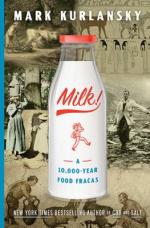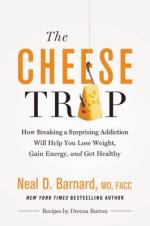June 21, 2018 | sobczakd
June is National Dairy Month! Americans love dairy products. We consume about 275 pounds of milk, cheese, yogurt, butter and ice cream a year! Consuming dairy products helps maintain healthy bones, teeth and gums throughout our lives. Nutrients found in dairy products include calcium, protein, potassium and vitamins. Want to learn more? Visit Maybury Farm in Northville where you can meet farm animals and learn about farming. And check out some amazing books about all things dairy and dairy substitutes!
A wide-ranging history of a surprisingly controversial form of nourishment. Milk, from humans and a variety of animals, is the subject of the latest enthusiastic investigation by the prolific Kurlansky (Paper: Paging Through History, 2016, etc.), winner of the James Beard Award and Bon Appetit's Food Writer of the Year Award, among other accolades. For 10,000 years, milk has been "the most argued-over food in human history," the author asserts, with experts opining about whether milk was fit for human consumption, whether babies should be breast-fed (and by whom—their own mothers or wet nurses), which mammal produced the best milk, whether milk should be pasteurized and homogenized, how cows should be raised and milked, and what effects such interventions as hormones, antibiotics, and genetically modified crops have on the milk we consume. Although many cultures feature milk-based creation myths, breast-feeding has long been a source of contention. Excavations of ancient Roman gravesites have turned up baby milk bottles, indicating that some babies were artificially fed. In the Middle Ages, artificial feeding was common, with numerous recipes for baby formulas; in 1816, one writer advised that babies should be suckled on goats, setting off a trend throughout Europe. Also popular was the employment of wet nurses, who often became live-in domestics. The choice of wet nurse was not simple: Many believed that the baby would inherit the nurse's disposition and traits; one doctor recommended that "a brunette with her first child, which should be a boy" made the ideal wet nurse. Especially in cities, spoilage, unclean udders, and unsanitary dairies caused illness and a great number of infant deaths. Pasteurization was a solution, but consumers complained about the taste. Debate about the safety of raw milk, much prized by cheese makers and organic farmers, still rages. Kurlansky looks at the production of milk and its uses in liquid and solid form (yogurt, butter, cheese, ice cream, pudding) around the world throughout history and into the present.Chock-full of fascinating details and more than 100 recipes.
The average American eats 33 pounds of cheese a year, and physician and veganism advocate Barnard (Power Foods for the Brain) asserts that giving it up could be a route to improved overall health. Cheese, he warns, is an essentially unhealthy product-filled with fat, cholesterol, and sodium-and has addictive properties as well. Despite an overly alarmist tone, Barnard is effective in explaining how the "ultimate processed food" is manufactured, and, with plenty of statistics to hand, why it isn't healthful. To this end, he raises the array of medical problems potentially associated with dairy or obesity. Barnard's antidote is a standard plant-based food plan. Readers can eschew cheese and create healthier versions of favorite foods by following 70 recipes developed by vegan cookbook author Dreena Burton for meals, snacks, and desserts. The book also lists versatile cheese replacements employing nut butters, non-dairy plant milks, coconuts, and soy.
The definitive guide to nondairy milks--the first comprehensive cookbook demystifying milk alternatives--here's how to make and customize all types of vegan milks, with one hundred delicious recipes and handy comparison charts, tips, and guidance for choosing the right dairy-free milks for cooking and baking. Got (non-dairy) milk? Whether you're paleo, vegan, lactose intolerant, kosher, or just plain adventurous in the kitchen, your non-dairy options now encompass far more than soy, coconut, and almond milks. Consider grain milks, such as oat and amaranth; nut milks, such as cashew and hazelnut; and seed milks, such as sunflower and hemp. Which ones bake the best biscuits? Complement your coffee? Make your mashed potatoes as creamy as mom's? The New Milks has the answers. The New Milks is the first bible of milk alternatives, helping you prepare, select, and cook with all varieties. With helpful charts comparing the texture, nutritional content, taste, and best uses for each milk, plus one hundred flavorful recipes, cooking and baking with non-dairy milks has never been easier! The first section of the book provides instructions for making an incredible range of non-dairy milks, followed by suggestions for use. Then, dive into recipes for breakfast, lunch, and dinner; sweets and breads; and smoothies and drinks. Each recipe calls for the ideal type of non-dairy milk, and most list alternates, so you can tweak them for your dietary needs and taste preferences. From "Buttermilk" Almond Waffles with Warm Berry Agave Sauce, to Mexican Chocolate Pudding, to Avocado-Basil Smoothies, every recipe is dairy-free, all but two are kosher, the vast majority are vegan, and most are gluten-free. Who needs the milkman when the alternatives are so much fun?
This first book by professional cheesemaker and blogger (sfmilkmaid.com) Hill is a wonderfully accessible-even empowering-guide for aspiring home cheesemakers. Beautifully illustrated with charming line drawings and tantalizing photographs of cheeses throughout, the guide is both instructive and delightful. Hill's personality and expertise shine through in the helpful tips and straightforward explanations of the art and science of transforming milk into cheese. Beginning with an outline of basic processes and equipment necessary, Hill introduces yogurt, farmer's cheese, and kefir before moving on to simple cheeses such as paneer and mascarpone. The bulk of the book covers favorites such as washed-curd (havarti), washed-rind (zeller), mold-ripened (Camembert), cheddar-style, stretched-curd (mozzarella), and pressed/aged (asiago) cheeses. Subsequent chapters include information about aging and storing. Closing material supplies a glossary, several helpful appendixes (on sanitation, cultures, etc.), lists of references and resources, and an index. VERDICT Lovers of dairy will eat up this thorough, lavishly illustrated primer and will soon be making cheese, yogurt, and butter at home. Delicious!
Her curiosity piqued by the multitude of French cheeses, essayist and self-proclaimed cheesehead Lison chronicles her tasty culinary journey exploring the art and science of French cheese making. Since she grew up in Wisconsin, the nation's largest producer of cheese, her "interest in cheese was inevitable." Following a perusal of a French cheese encyclopedia describing more than 350 kinds of fermented milk, the author poses a basic question: "Why produce this crazy number of cheeses? I mean, why not just one nice sharp cheddar?" Lison's query engendered nearly 7,000 miles of travel and the consumption of copious amounts of artisanal cheese. The author trekked from high alpine barnyards to sparkling multinational corporate headquarters, talking with shepherds and scientists. Along the way, Lison discourses on the merits of hand milking vs. portable milking machines and the history of the classification system, which consists of five basic types of cheese. The author explores what makes some cheeses so stinky and why, since the Middle Ages Roquefort, cheese and the concept of appellation have been intertwined. Lison attended what she calls a "cheese-tasting debutante ball" and explains the real meaning behind the Camembert War. "Camembert however, is the dream of the French cheese," she writes, "a fromage so closely linked with Frenchness in the minds of people everywhere that just the name Camembert' evokes visions of berets and fleurs-de-lys." The author laces the narrative with satisfying kernels of French agricultural history, especially data concerning the pressures of the post World War II environment and its role in hollowing out the population of the French countryside. Whether Lison is ruminating on the short lactation cycle of sheep, the origins of rennet, or the grassy, lemony taste of a spring goat cheese, readers will have all their senses engaged.
A beguiling, multifaceted narrative larded with delightful culinary, historical, political, psychological and literary layers, set in the kingdom of Castile with a piece of cheese in the starring role. Paterniti (Driving Mr. Albert: A Trip Across America with Einstein's Brain, 2000) gracefully unravels how tradition, culture and a sense of place affect the human heart, while simultaneously wrestling with the joys and boundaries of storytelling and journalism. During a 1991 proofreading stint at a deli, following his graduation from the University of Michigan's creative writing program, the author read a paragraph describing a "sublime" cheese from Castile. "There was something about all of it, not just the perfection of Ari's prose," writes Paterniti, "but the story he told--the rustic cheesemaker, the ancient family recipe, the old-fashioned process by which the cheese was born, even the idiosyncratic tin in which it was packaged--that I couldn't stop thinking about." Years later, the author, determined to find the storied cheesemaker and learn his tale, set off for Spain on what became a 10-year odyssey. Paterniti rapidly fell under the spell of the loquacious cheesemaker, Ambrosio, and the tiny village of Guzmn, situated in the "vast, empty highlands of the Central plateau of Spain." At the center of the narrative is the saga of betrayal of Ambrosio and his artisanal cheese by his boyhood friend, Julian. Paterniti's quest for the true story surrounding the creation and demise of Ambrosio's cheese rambles in delightful directions. The author probes subjects as diverse as the first human encounter with cheese; an investigation into the origin of Pringles; geology; and Spanish "legends, farces and folktales." Enriched by Paterniti's singular art of storytelling, this is a deeply satisfying voyage across a remarkable landscape into the mysteries and joys of the human heart.
"The family farm lies at the heart of our national identity, and yet its future is in peril. Rick Hammond grew up on a farm, and for forty years he has raised cattle and crops on his wife's fifth-generation homestead in Nebraska, in hopes of passing it on to their four children. But as the handoff nears, their small family farm--and their entire way of life--are under siege. Beyond the threat posed by rising corporate ownership of land and livestock, the Hammonds are confronted by encroaching pipelines, groundwater depletion, climate change, and shifting trade policies. Add GMOs, pesticides, and fossil fuel pollution to their list of troubles and the question is: can the family farm survive in America?"--Jacket flap.
This companion to the documentary Cowspiracy explores the impacts of the most environmentally destructive industry on the planet: animal agriculture. It presents the alarming truths about the effects of animal agriculture on the planet. One of the leading causes of deforestation, greenhouse gas production, water use, species extinction, ocean dead-zones, and a host of other ills, animal agriculture is a major threat to the future of all species, and one of the environmental industry's best-kept secrets.







